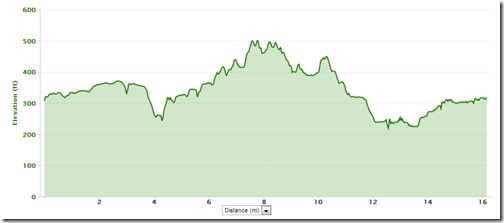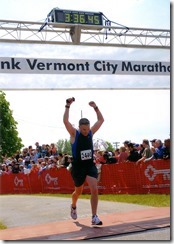 If you’ve ever had the chance to see how elite runners train, one thing that becomes apparent very quickly is how their approach to pace/effort is different from most amateur runners. Elite runners tend to run their workouts really hard when it’s called for, and they run really slow (relatively speaking) during warm-up and on recovery runs. For an example, take a look at the pacing approach of 2016 Olympic Marathon Trials qualifier Cole Atkins – he routinely runs paces varying from 8:00/mile down to sub-5:00/mile in his training. He often covers this entire range in a single run!
If you’ve ever had the chance to see how elite runners train, one thing that becomes apparent very quickly is how their approach to pace/effort is different from most amateur runners. Elite runners tend to run their workouts really hard when it’s called for, and they run really slow (relatively speaking) during warm-up and on recovery runs. For an example, take a look at the pacing approach of 2016 Olympic Marathon Trials qualifier Cole Atkins – he routinely runs paces varying from 8:00/mile down to sub-5:00/mile in his training. He often covers this entire range in a single run!
In contrast, a really common habit for the rest of us is to fall into a single pace or effort on our training runs. We either run the same easy pace day after day, or we try to push each run to the point where we burn out. And when we do vary pace, it’s often over a much narrower range – maybe 75-90 seconds vs. the 3 minute range covered by Cole Atkins in the example above. If you want to get the most out of your training and your body, you need to take a page out of the elite training book and work both ends of the speed/effort spectrum and everywhere in between. Here are three major reasons for varying your pacing from workout to workout.
Distribution of Impact Forces
Rightly so, the concept of varying impact force distribution has been getting more attention lately. For example, this appears to be a major factor behind the benefits we can get from rotating shoes of different types/designs from day to day. Similarly, when you vary your pace from one workout to the next you vary how forces are applied to the body and may thus reduce the likelihood of suffering a repetitive overuse injury. The keys here are the subtle differences in stride length and stride rate that naturally occur at different paces (both rate and length of stride tend to increase with faster pace). These little differences create different impact angles, and therefore different shock absorption profiles in your body. Over a lot of strides through a lot of runs, this can mean the difference between being healthy or dealing with one of the classic running injuries like IT Band Syndrome, Achilles Tendinitis, or Runner’s Knee. So, pace variation can be an important part of injury prevention.
Energy System Training
We have multiple pathways to deliver energy to our muscles, and they are largely regulated by effort. Most easily measured in terms of heart rate, we’re relying on very different sources of energy when running a very easy effort (aerobic) versus running a very hard effort (anaerobic). And, this isn’t just a “one or the other” scenario, as we’re always using a blend of both aerobic and anaerobic energy when we run. The more we train a particular energy system, the more efficient it becomes. When we train across the entire spectrum of effort, we build a much better engine for future running and racing. This allows us to be able to change gears in races, finish them strong, and run for longer distances. So, pace variation is also a part of speed and endurance development.
Adaptation
For people who have become serious about running, taking each day too hard is a more common problem than taking each day too easy. This is an easy trap to fall into; at first, pushing it on a daily basis leads to a lot of improvement. The problem arises when, inevitably, all of the hard training catches up with the runner and they find they are either unable to run as fast as they recently had been, or they succumb to an injury. Seasoned runners have learned (maybe the hard way) that adaptation must always be considered and respected. It’s really true: You don’t actually get faster when running faster, you get faster when your body has a chance to adapt and compensate for the training you’ve completed. This is why recovery runs are important – mixing in slower runs after hard workouts allows the body to recover and adapt to hard training without breaking down. So, in summary, pace variation from workout to workout plays an important role in allowing the body to adapt over time.
How To Estimate Your Training Paces
A good training approach will feature pacing that goes all the way from very easy to max-effort sprints. When mixed together in the right combination, significantly more progress can be made at the same time that injuries and layoffs can be avoided. Just remember: Hard days hard, easy days easy, and make sure you touch everywhere in between along the way.
To get a ballpark estimate of paces for various types of workouts, check out the McMillan Running Calculator or the Jack Daniels Running Calculator. Both allow you to input a recent race time as a way to tailor paces to your current level of fitness. A word of caution – be careful with the race pace predictors on these sites. Without adequate training, your best time in a 5K may not accurately predict what you are capable of in a longer race like a half-marathon or marathon.
Editor’s Note: Ask Coach Caleb is a new feature on Runblogger. If you have any training questions you would to be considered for a future post, please leave a comment!

















I have a question – I’m wanting to improved my 10K times, and have recently increased my training from 4 to 5 days a week, but I really don’t know if that’s going to benefit or not. I already do 2 “quality” workouts a week (intervals and/or tempo) and a long run. I guess my question is what is the benefit of running 1 more easy run a week? (I’m assuming it would be an easy run because most training plans I’ve seen work on the principle of 2 workouts + long run as the basis).
Arlina – thanks for the question! I actually think Caleb is going to tackle this issue in next month’s column.
Excellent article, and couldn’t agree more. One slight caveat though is that elites can vary their pace across a much wider range than the rest of us because their fastest pace is so fast.
I disagree to an extent. I’m far from elite, and my pace range varies from 9:00/mile down to well below 6:00/mile. The entire scale slides up and down based on ability. Though I would agree in reference to a new runner – most of my beginner group runs at about 11:00-12:00 per mile, and at this point I would not be comfortable recommending that they try to do any faster running. They need to build up strength and endurance first and risk of injury by introducing speed is too high.
I’m on board with Pete here – in the same “sub-sub-sub-elite” category, and my paces can cover a little over 3:00/mile. First mile of my warm-up is usually 9:00+, and faster pace intervals dip below 6:00/mile. I feel much better on my runs after a really easy first mile or two.
One thing that wasn’t totally explicit here, but mentioned in better detail on Caleb’s blog, is that the elite runner mentioned here is generally only doing 8:00 miles for his first mile or two as warm-up. After that his easy run pace is around 6:30.
One thing that is important for me with that warm up mile is allowing my form to settle in. I’ve been dealing with a dodgy knee for awhile and it takes about a half mile for it loosen up and feel good. If I hit the ground running fast right out the door I fear I might do some damage. A slow first mile and I’m good to go.
I just finished reading Run Less Run Faster and the rationale seems very similar. My question is how much range is too much? I did a track workout ladder (400, 400, 800, 1600, 800, 400, 400 w/ 400 recoveries) and my max speed was 6:00’/mi while recoveries were run right at 10:00’/mi. Too slow/fast? Should I be doing 6:30/9:30 as my range? Does it matter?
Dave, that really depends on your goals and current fitness. I’d guess that as long as you’re able to hit your goal paces for each interval, you’re not doing it too fast. But (as you’re likely aware), base your target paces around your race pace goals, don’t just run them as fast as possible. For example, you could aim for 1 mile, 5k, and 10k paces for your 400, 800, 1600 intervals. So your race goals should really drive what your max pace is.
The amount of recovery sounds fine, but might want to progress to less recovery as you approach a goal race. Either shorten the distance of the recovery or increase the pace on the 400m recovery. But decrease the recovery gradually, and don’t do it to the extent that you lose quality on the intervals.
That’s very helpful, thank you! I’d say my current race goals are tricky because it’s triathlon season and all of my training has been to improve the run times. I suppose my 5k goal in a sprint tri is sub-7:00’/mile, but maybe I can do 6:45s?? Hard to say. Just aiming to go fast at the end of a tri!
Dave-
Sorry, I meant to append the response with something along the lines of “that’s my take based on my experience, but I’d be real curious to hear what Caleb thinks of your intervals”. Good question for him to tackle.
Trail Running Dad is right on the money here. In terms of easy running and most recoveries, there really is no such thing as “too slow.” And, the targets for your intervals should absolutely be based on upcoming goals. There are a couple special situations where I will call for a “recovery” that is at a more moderate effort (these are called floats) to train the ability to process/burn lactate, but that’s for very specific training stimulus. In general, you should recover as slow as you need to in order to hit the target for the next interval. As you improve fitness, you can reduce the recovery time.
I’m only six months in to running seriously, and I’m slow. A comfortable pace for me is about 9:30 per mile. But if I plug that into a calculator, I get something like 12:00 per mile for a training pace, which seems to be ridiculously slow, even for me. I think I need to learn how to push it more, but I worry about injury risk.
Thoughts on learning pacing for relative novices?
Emby, the best way to set a baseline is to run a race (5k, etc) and then plug that into a calculator for some guidance. If you have one, you can also use a heart rate monitor to see how various paces translate to necessary effort. Easy runs should be around/under 70% of your max HR. The old school way to check easy pace is to make sure you can talk easily while running (i.e. run at a “conversational” effort).
The great news is newbies improve fast, so you’re likely going to see some jumps in your easy pace as you keep running consistently!
Thanks! I somehow pulled an 8:48 pace during a relay marathon yesterday, and so now I think I have a little more guidance.
Very interesting post, and a great addition to the blog.
I’d love a post going a bit deeper into the subject of varying paces and running workouts, such as how much speed work to do a week, what kind is best (intervals, tempo, etc), and how to approach speed work pace vs race pace (same, faster, slower, relation of speed training pace with distance of training run).
Spent a little while thinking on this, but I’ve got 2 questions I’d like to get Caleb’s opinion on.
1. Cross-training. I’m in the back end of my 30s, and I keep hearing about how masters runners can benefit from incorporating cross-training as opposed to solely running. How would I determine when I’ve reached that point? Is it a matter of starting to encounter injuries more frequently? Or is the benefit more that legs are fresher for the real workouts, while still getting some aerobic benefit on easy days? I’ve been running fairly consistently for the last 2 years (had only really run occasionally since high school), last year I’ve averaged 30-35 miles without any injuries to speak of.
2. How to fit in workouts in limited training time? This one’s for the wife, she’s gotten back into running for the past year or so, after the birth of our son. Because of work & parenting responsibilities, she’s able to get in about 2.5 hours of running per week, about 15 miles, over 3-4 runs. Usually 1 longer run (5-6 miles) and 2 or 3 shorter runs, all at fairly easy pace but with some strides at the end of 2 of those runs. Given her time constraints, what do you think would be the most beneficial change to her routine?
Really appreciate your time here and on your own blog. Thanks!
Great questions. I’ll touch on these in detail during next month’s post on “How to Structure a Training Week,” but here are some brief responses for now.
1. There’s nothing magic, good or bad, about turning 40 and becoming a masters runner. Age is just one factor that impacts training like many others. Just like all things running, recovery time and adaptation rate are different from person to person. For this reason, I think the question of how much to run versus cross-train should depend on how you feel on quality days. I encourage people to (a) run less and cross-train more, (b) space workouts more days apart, or (c) do both, when they start to feel like they don’t have the “pop” in their legs on quality workout days. Injuries would be another big tip-off, particularly if they are of the overuse variety (tendinitis, IT band inflammation, persistent joint soreness, etc.). Usually, though, it’s mainly about feeling fresh for quality days.
2. Given any constrained schedule (i.e. everyone’s real life in this day and age), I recommend first setting a routine. This seems to be set in your wife’s case. When that is done, I then want to begin adding varied (this is key) speed work. If you can’t add time or distance, the way you can keep challenging your body is to provide different training stimuli from week to week. So, one week could be some hill repeats, the next fartlek, the next a tempo, and so on. As long as you keep changing the variables, the body will continue adapting and getting better, even within the same amount of training time per week.